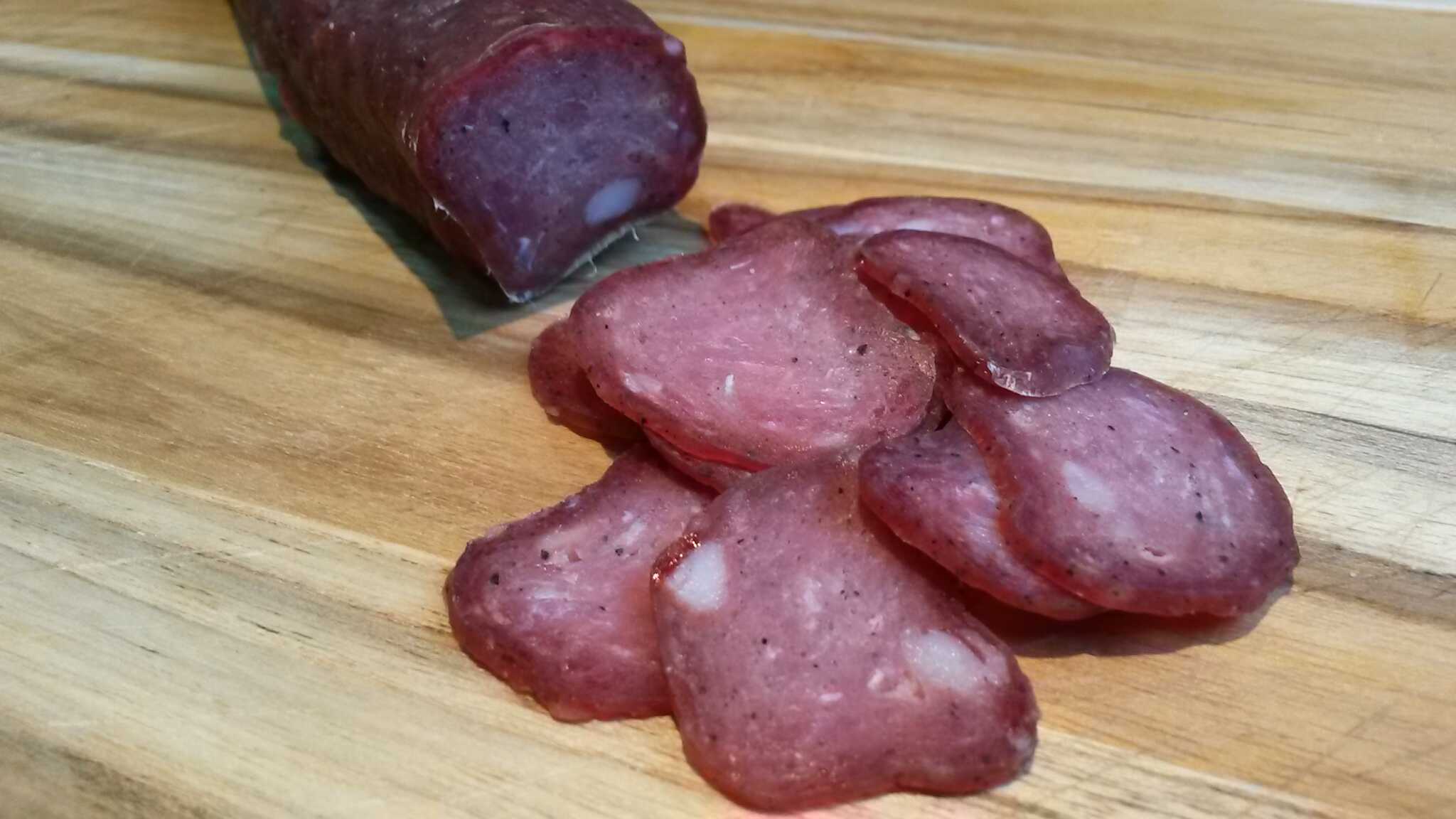
O salame é uma das formas mais simples e exuberantes na arte do trato da carne. É uma alquimia que transforma um pedaço de carne cru em um produto extremamente saboroso e durável. Criar um produto de qualidade expondo um pedaço de carne ao tempo, sem absolutamente nenhum tipo de cocção é algo fascinante!
Preparar um salame é algo que requer tempo, atenção nos detalhes, higiene e olho atento nos problemas que podem ocorrer no decorrer do processo. É uma arte que requer um mínimo de conhecimento técnico e cuidados na execução. Qualquer um pode fazer um salame, mas é preciso motivação e paciência, tanto na aquisição de informações quanto no processo de preparo. Errar, jogar fora, pesquisar a origem do erro e começar de novo faz parte do processo!
O ideal é que já esteja familiarizado com o processo de fabricação de linguiças e que tenha certa prática com o processo de moagem da carne, trato do invólucro e enchimento, pois o salame é um passo adiante, caso nunca tenha embutido nada, leia o posto sobre como fazer linguiça. Se quer mesmo fazer um salame em casa, essa receita é a mais simples e recomendável para iniciar nessa jornada. É uma receita básica que leva apenas sal, agentes de cura, pimenta do reino e alho, mas o resultado é surpreendente principalmente para quem comeu apenas versões industrializadas.
O primeiro passo é ter um moedor de carne, que pode ser um manual de manivela ou automático caseiro, como este abaixo que uso da kitchenaid. Ele executa bem o processo de moagem, mas não é bom para embutir, abaixo falo mais sobre isso. É possível cortar a carne com a mão, mas é preciso uma faca excelente e muita, muita paciência.

O próximo equipamento necessário é para embutir a carne dentro do invólucro. Uso a mesma kitchenaid com o adaptador para embutir, mas não é uma ferramenta boa pois é preciso fazer muita pressão para que o processo aconteça. Recomendo que adquiram um canhão vertical manual de 2 quilos. Infelizmente no Brasil eu desconheço um equipamento desse, se alguém souber de algum, por favor deixe a dica nos comentários.


Fermentar e secar o salame é a parte mais desafiadora e necessita de um ambiente controlado, com temperatura e umidade específicas, variações podem ocorrer, mas não muito grandes. Para esta etapa utilizo uma pequena adega com controle de temperatura. A umidade controlo com um higrômetro dentro da adega e um recipiente com água e sal. Desta forma consigo acompanhar a umidade e aumentar ou diminuir a umidade com mais ou menos recipientes com água. É importante colocar sal nesta água para evitar a formação de bolor no recipiente.

Aditivos funcionais
Nitrato de sódio – é o famoso sal de cura que serve para dar cor, sabor e preservar. Pode-se usar nitrito de sódio, nitrato de sódio ou uma mistura de ambos, mas o nitrato é o mais recomendado para curas longas. Para entender melhor o sal de cura, leia o post Sal de cura o que é e quanto usar.
Cultura starter – serve para dar sabor,aroma e ajuda na prevenção de contaminação.
Sal de cozinha – Pode parecer só um tempero, mas é o ingrediente mais importante na preservação e sabor.
Invólucro/Tripa – Utilize tripa de colágeno ou natural. Compre uma com calibre elevado(40mm ou superior), corte no tamanho desejado e, caso uma das pontas não venha presa, amarre uma das pontas com um barbante. O mais fácil é comprar uma tripa já preparada para fazer salame, ou seja, já cortada no comprimento certo e com um grampo de aço ou barbante amarrado em uma das pontas.
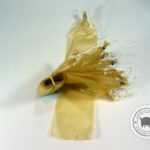
Sequência de passos para fazer salame artesanal
- Escolher, limpar, moer/cortar a carne e a gordura;
- Adicionar os temperos e aditivos funcionais;
- Misturar bem para trabalhar a proteína(dar liga na miosina);
- Embutir;
- Fermentar em temperatura ambiente e umidade alta para desenvolver a cultura inserida(fermento cárneo);
- Dessecar, ou seja, maturar/secar o salame com temperatura e umidade controladas.
Ingredientes
- 2 kg de pernil de porco;
- 200g de gordura da barriga ou retirada da pele do próprio pernil, o importante é que a gordura seja rígida;
- 50 gramas de sal (equivale a 2,5% do total de carne);
- 6 gramas de sal de cura 2 (6% de nitrito, 3% de nitrato e 93,75% de sal) – (equivale a 0,3% do total de carne);
- 10 gramas de pimenta do reino moída;
- 30 gramas de alho;
- 1/3 de xícara de vinho tinto (opcional);
- 1/4 de xícara de água filtrada(para misturar a cultura);
- 0,1 grama de cultura starter (bactérias láticas) para carnes;
- Tripa natural bovina ou tripa de colágeno 45mm ou superior.
Preparo do salame artesanal
Prepare a tripa
Tripa natural bovina: enxague bem e deixe mergulhada na água enquanto prepara o restante.
Tripa de colágeno: hidrate em água com 10%(1 litro de água e 100g de sal) de sal por 5 a 10 minutos.
Limpando a carne e a gordura
A carne pode variar, pode ser apenas pernil, paleta ou mistura de carne bovina e suína. O importante é comprar uma carne de boa procedência. Limpe-a, remova ossos, pele e o máximo que puder de tecido fibroso, nervos e tudo o que não for proteína. Aproveite para separar a gordura do pernil que também pode ser usada. Corte a gordura em cubos pequenos, de meio centímetro ou menos e a carne em cubos grandes de 2 cm.
Congele a gordura picada separadamente e refrigere bem a carne quase no ponto de congelamento, isso é importante para a gordura da carne não derreter durante a moagem.
Processando a carne e misturando os ingredientes
Moa ou corte bem finamente a carne. Dissolva a cultura na água filtrada e adicione juntamente com todos os demais temperos e aditivos, menos a gordura congelada, e misture bem até ficar bem pegajosa, grudenta. Depois que estiver bem misturada, adicione a gordura congelada até que fique bem espalhada. Retorne para a refrigeração.
Embutindo
Deixe sempre um espaço no final da tripa para conseguir fechar a extremidade, pode dar um nó, prender com um grampo específico ou amarrar um barbante. Após ter enchido todas as tripas, fure com uma agulha esterilizada qualquer bolha de ar que houver, também faça furos aleatórios por todo o salame para facilitar a dessecagem.

Fermentação
Esse processo é importante pois possibilitará que a cultura adicionada prospere e acidifique o salame, reduzindo as chances de aparecimento de outros organismos contaminadores.
Deixe o salame repousar em temperatura ambiente e umidade elevada, por volta de 80%, durante 12 horas. Nesse tempo a cultura adicionada irá proliferar rapidamente inibindo o surgimento de outros organismos nocivos.
Maturação
Esse processo é longo, pode levar entre 20 e 60 dias dependendo do ponto que deseja, quando mais tempo, mais saboroso e rígido o salame ficará.
O importante é manter a temperatura em aproximadamente 14 graus. Já a umidade, deixe nos primeiro 5 dias em 80% e depois disso abaixe para 70%. Mantenha essa umidade até o final do processo. Particularmente prefiro mais tenro, então deixo entre 20 e 30 dias. Vejam nas fotos que este salame que fiz está com o miolo ligeiramente mais claro que o exterior, isso porque ainda tem uma quantidade boa de umidade. Se ficasse mais 10 ou 20 dias estaria todo escurecido e bem mais rígido. Mas é uma questão de gosto!

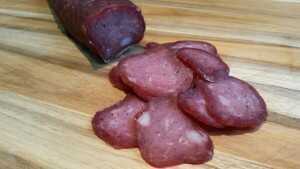
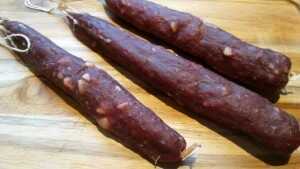
Mofo
É normal aparecer mofo no salame durante a maturação, caso isso ocorra siga as instruções do post Mofo no salame e em outros embutidos.
Conservação
O ideal é remover a tripa, limpar, passar azeite e embalar bem, preferencialmente a vácuo, e refrigerar, desta forma o salame durará por, no mínimo, 90 dias. Caso não tenha seladora a vácuo, embrulhe com várias voltas em filme pvc e mantenha refrigerado.
-
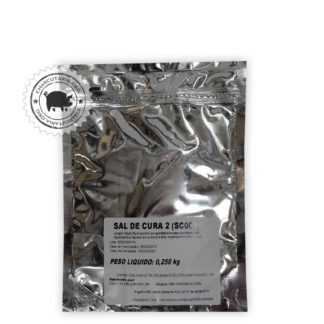 Sal de cura 2R$ 8,00
Sal de cura 2R$ 8,00 -
 Sal de cura 1R$ 8,00
Sal de cura 1R$ 8,00 -
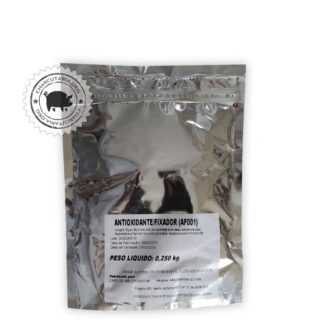 Antioxidante FixadorR$ 23,00
Antioxidante FixadorR$ 23,00 -
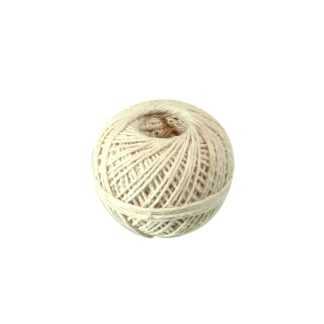 Barbante culinárioR$ 7,90
Barbante culinárioR$ 7,90 -
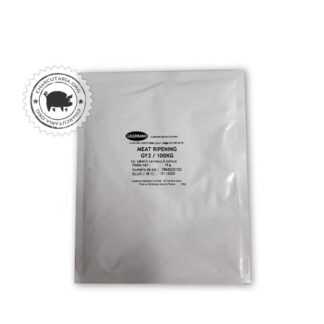 Cultura StarterO preço original era: R$ 69,90.R$ 59,90O preço atual é: R$ 59,90.
Cultura StarterO preço original era: R$ 69,90.R$ 59,90O preço atual é: R$ 59,90. -
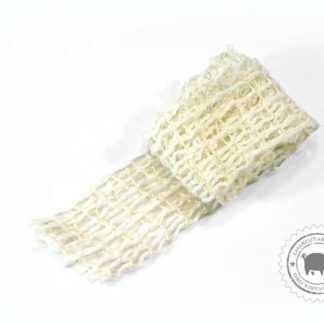 Rede elástica culinária 50mmR$ 15,00
Rede elástica culinária 50mmR$ 15,00 -
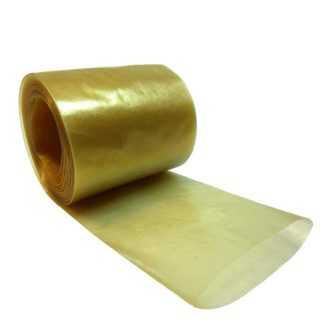 Tripa de colágeno 45mm rolo 5 metros salameR$ 25,00
Tripa de colágeno 45mm rolo 5 metros salameR$ 25,00 -
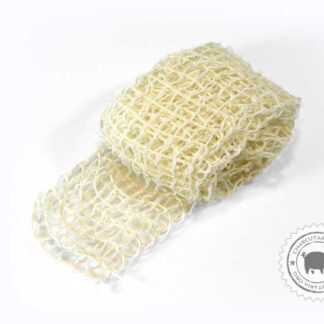 Rede elástica culinária 65mmR$ 18,00
Rede elástica culinária 65mmR$ 18,00 -
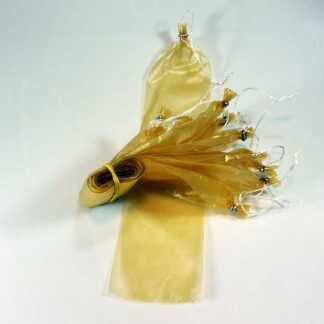 Tripa de colágeno salame 45mm 10 unidades amarradasR$ 22,00
Tripa de colágeno salame 45mm 10 unidades amarradasR$ 22,00 -
 Tripa de colágeno 80mm copa e salameR$ 29,90
Tripa de colágeno 80mm copa e salameR$ 29,90 -
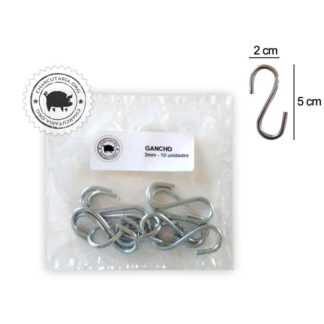 Gancho GalvanizadoR$ 12,00
Gancho GalvanizadoR$ 12,00 -
 Tripa de colágeno salame 50mm 10 unidades amarradasR$ 24,00
Tripa de colágeno salame 50mm 10 unidades amarradasR$ 24,00


Boa noite,
Parabéns pelo conteúdo e obrigado por compartilhar para que possamos aprender mais a respeito.
Tenho dúvida em relação a utilização da cultura starter, é realmente necessária? Posso substituir por vinho/vinagre sem perder a qualidade do produto? Estou falando em produção caseira, de poucas peças para consumo próprio.
Oi Marcio. Sim, pode fazer sem a cultura starter, ela é um complemento que aprimora o produto, mas é possível fazer um ótimo salame sem a cultura starter. O vinho vai ajudar a acidificar e proteger o salame, simulando um dos efeito da cultura, que é o de reduzir o pH através das bactérias láticas.
Obrigado, alguma medida específica para vinho? Devo fazer cerca de dois kg pra um teste inicial.
Utilize 50ml de vinho para casa 1kg de carne.
Boa tarde posso secar o salame em uma área da casa cobertura de telha de barro somente ventilação natural
Para ambientes sem refrigeração recomendo que faça apenas os salames rápidos, como o colonial: https://charcutaria.org/receitas/receita-de-salame-colonial/
O meu salame ficou muito seco, fem alguma produto que eu posso colocar.
Oi Valdecir. Pode acrescentar uma porcentagem maior de toucinho no seu salame, com mais gordura ele ficará mais macio. Talvez o salame tenha ressecado pelo ambiente com pouca umidade. Quando o salame fica pendurado em um local muito seco a tendência é que o salame fique mais rígido, ressecado, principalmente por fora.
Bom dia, Eduardo fizemos o salame, deixamos 3 dias entre 23- 24graus com umidade 85-90, levamos ao defumador a frio por 3 horas e então levamos à camara de maturação entre 12-13 graus e 70-75 de umidade na data de 03/06 com peso de 504gr. E hoje já está com 338gr. Estou achando perda de peso muito rápida. E normal? Estaria pronto para consumo?
Oi Meire, o processo está perfeito. De 504g para 338g perdeu 33% do peso, ainda está muito cru, melhor aguardar até estar com 300g. Se puder aumente um pouco a umidade entre 80 e 85%, desta forma vai desacelerar um pouco a perda de peso e dar mais tempo da maturação desenvolver sabores e aromas. No início do processo e em salames mais finos a perda de peso é acelerada. Outra questão é a ventilação, pode reduzir e apontar indiretamente para os salames.
Eduardo boa tarde. Parabéns pelo seu trabalho. Fiz meus primeiros 2 salames neste fim de semana. Não achei sal de cura e usei mistura pronta da Aglomax Salame e adicionei alguns ingredientes a mais. Usei Yakut como fermentador. Estou deixando 3 dias suspensos em temperatura ambiente e depois vou passar para uma adega exatamente como a que vc descreve no site. A dúvida é se usando Yakut este período de fermentação em temperatura ambiente é correto ou melhor colocar na adega no princípio do processo?
Obrigado pela sua atenção.
Oi Ricardo, como está fazendo sem o sal de cura e o yakult não é uma cultura starter testada para esta finalidade, então recomendo que coloque de imediato na adega com a temperatura por volta de 12ºC. Depois poste o resultado, abraços!
Mais uma vez obrigado pela sua atenção.
Bom dia Eduardo, dando sequencia nesta consultoria, hoje pesei os salames. Em 5 dias perderam 26% do peso, estou usando uma adega como câmara de maturação e secagem, esta atingindo 14C e 78% de umidade. Usei Yakult e não notei ainda a formação do mofo branco. Pergunto: 26% nos primeiros 5 dias é normal? segundo; a partir de quantos dias começa a formar o mofo branco, alias, tem que formar o mofo branco. Pretendo deixar secando até atingir 35% ~40% de redução de peso..
Obrigado mais uma vez pela sua atenção…
Oi Ricardo, nos primeiros dias o salame costuma perder mais peso, depois reduz bastante a perda. Mas reforce a umidade da adega com alguns potes com água para tentar desacelerar um pouco essa perda. Sobre o mofo, o yakult não tem essa propriedade pois é uma cultura bacteriana e o mofo é uma colonização de fungos. O ideal quando não é aplicada uma cultura de fungos(geralmente penicillium) é que não cresça nenhum mofo nos salames. Caso apareça mofo o ideal é remover o quanto antes. Só é recomendável deixar o mofo alastrar quando é aplicada a cultura de fungos penicillium. Recomendo que deixe perder 40% pois abaixo disso o salame tende a ainda estar um pouco mole.
Grato pela resposta, e pelos otimos precos da loja…
Bom dia Eduardo, uma duvida, li algumas respostas e observei qua nao a necessidade de deixar o salame por tres dias para cura longa correto? Qual o tempo ideal no caso para efetuar a defumacao a frio apos o salame pronto..?
Oi Almerio, os 3 dias são para os salames fermentados que fazem uso de cultura starter. Caso não use a cultura starter então o indicado é não ficar os 3 dias em temperatura ambiente. O tempo de defumação vai variar, pode ficar 2, 3, 8 horas ou até um dia inteiro, depende da intensidade desejada. O importante na defumação fria é que a temperatura no defumador não ultrapasse os 40 e poucos graus. Eu prefiro defumar o salame logo após embutir e depois pendurar para secar/maturar pois a defumação agrega proteção extra.
Boa Noite!
Qual seria o melhor vinho para temperar o salame?
Oi Glaydson, não há regra, use o vinho que achar melhor. Pode ser tinto ou branco.
Muito obrigado!
Boa noite,
Me ajude por favor… eu estou fazendo meu primeiro salame, temperei a carne com temperos a gosto normalmente e sal de cura 2, adicionei vinho 180ml em 2kg de carne suína. Eu só deixei descansar por 6 horas na geladeira e depois ensaquei na tripa de colágeno e furei todinha com agulha.
Deixei eles pendurados na minha cozinha coberto com um guardanapo de pano onde pretendo deixar por 3 dias antes de por na geladeira , mas o detalhe é que com 24 horas fui tirar o guardanapo para dar uma olhada e de um lado deles ficaram escuro, provavelmente o lado que pegou mais claridade e já tem um pouco de mofo branco.
A parte da ponta onde esta pendurado ficou mais escuro também, isso é normal ou meu salame já deu sinal que esta estragando?
Achei este site agora e vou seguir as receitas daqui de agora entediante. Desde já agradeço!!
Oi Cleverson. Vou tentar te ajudar por partes: 1) salame com partes escurecidas: O salame geralmente fica escuro de forma uniforme pela oxidação. oxigênio, luz e calor são os principais meios que propiciam a oxidação. No seu caso acredito que tenha sido o excesso e luz. Mas não há necessidade de furar a tripa, apenas onde houver bolhas de ar visíveis(exatamente para remover o ar e evitar a oxidação nessas regiões). Como o ar contém oxigênio então quanto mais furar mais irá propiciar o escurecimento pela oxidação. Muitos ensinam a furar a tripa toda, mas é uma mania desnecessária que mais atrapalha do que ajuda. Não significa que esteja estragando, significa que nessas regiões o salame oxidou, não é uma contaminação, apenas uma região em que o sabor pode ficar alterado. 2) 3 dias pendurado em temperatura ambiente: só faça isso caso tenha usado uma cultura starter, caso contrário não é recomendado fermentar o salame. Vá direto para o ambiente refrigerado. Recomendo que, caso vá fazer na geladeira comum, use uma caixa ou outro ambiente fechado como neste receita: salame-artesanal-feito-na-geladeira 3) mofo branco, cinza, verde…: só mantenha mofo caso tenha aplicado uma cultura mold penicillium. Caso contrário sempre remova qualquer… Leia mais »
Muito obrigado pela grande ajuda Eduardo, um forte abraço!
Boa noite. Sabe dizer como eh possível controlar a umidade numa adega de vinho. Não consigo por exemplo deixar com 70% e em outro momento aumentar para 80%. Adicionando um pote com água e sal contribui para aumentar e removendo o mesmo pote diminui. Grato por qualquer dica a respeito.
Oi Luís. Adicionando potes com água ou panos úmidos no interior da adega irá aumentar a umidade. No início a umidade do próprio salame é alta então a umidade da adega tente a ficar bem elevada, posteriormente conrofme os salames perdem água a umidade tende a reduzir. É necessário acompanhar e ajustar os potes com água ou panos úmidos conforme a necessidade do momento. Como as adegas são bem fechadas então a umidade tende a ficar bem estável, não é difícil controlar.
Adquiri um salame artesanal que perece “fresco” pois ainda não está com aquela aparência curtida. Quando me venderam apenas disseram que em 3 ou 4 dias estaria como os demais “curtidos”. Parece que não é bem assim. O que devo fazer com ele neste estágio em que está ainda “mole”, deixá-lo ao ar livre ou na geladeira?
Oi Mauro. Na verdade pode consumir assim pois o salame colonial é assim mesmo. Caso queira ele mais firme pode envolver em papel manteiga e deixar uns 15 a 20 dias na geladeira. Vai ficar mais firme mas não vai ficar perfeito como um salame maturada corretamente. Eu comeria mole mesmo pois é assim que são os salames coloniais do sul do Brasil.
Obrigado Eduardo! Valeu a dica! Forte abraço!
Boa tarde! Eu vou fazer alguns salames e vou utilizar a cultura, tenho uma duvida, a cultura depois de aberto como faço para guardar o restante, pois vou usar pouca coisa, e outra duvida é se é obrigatório usar a cultura na produção do salame?
Abraço.
Oi José. A cultura é um ingrediente opcional, vai ajudar na proteção e dar um pouco mais de qualidade ao produto dependendo da cultura que estiver utilizando. Pode usar apenas o suficiente e depois fechar bem a embalagem original e guardar no congelador. Costuma durar bastante tempo sem perder o efeito. Abraços!
Boa Noite Eduardo
Primeiramente parabens pelo site e dicas, tem ajudado e muito.
Fiz a minha receita de salame.
Deixei fermentando por 48 horas em temperatura ambiente. Fiz uma receita com a cultura sbm 11.
Ensaquei em tripa de colageno 50
Apos as 48 horas, pendurei em uma camara / geladeira improvisada onde controlo a temperatura e umidade atraves de um termometro diariamente entre 12 e 14 graus e umidade entre 70 a 85.
Apos os 7 dias notei que a perda de peso foi muito rapida, em torno de 27%.
Visto que vejo em varios comentarios e dicas suas que perde em torno de 40% entre 14 a 21 dias, ou ate mais tempo.
E os salames nao estao tao secos pela quantidade de peso perdida ja.
Isso é normal? O que pode estar ocorrendo?
Talvez quando perder uns 40% estarao consumiveis, mas mais macios do que secos?
Pode ser a temperatura?
Ainda nao notei nenhuma presença de mofo.
Abs e muito obrigado
Oi Julio. Pelo que descreveu está tudo perfeito. No início do processo os salames tendem a perder peso mais rapidamente, essa taxa vai reduzir com o tempo. Conforme os salames perdem umidade a quantidade de água disponível é reduzida e consequentemente a perda de peso é desacelerada. A quantidade de umidade inicial, a temperatura, o tipo de tripa, a ventilação e a umidade da câmara influenciam a taxa de perda de peso do salame. Não vejo necessidade, mas caso queira desacelerar o processo pode aumentar a umidade, reduzir ou eliminar a circulação de ar(se houver) ou diminuir a temperatura. Caso goste do salame mais rígido pode retirá-lo com 45% de perda de peso. Em alguns casos tiro com 50% de perda, ficam bem mais rígidos e compactos, com sabor bem intenso. Mas a receita também influencia nessa decisão pois caso tenha usado uma concentração de sal alta(perto de 3%) então é desaconselhável secar demais, pois o sal ficará muito forte. Mofos devem surgir sim, muito difícil ficar imune. Limpe a superfície dos salames sempre que notar algo estranho. Depois conte como ficaram. Abraços!
Boa noite Eduardo.
Apos 4 semanas os salames perderam de 40 a 45% do peso.
O sabor esta muito bom.
Na tripa de colageno de 60 desgrudou um pouco, mas ao abrir ficaram consistentes.
Na tripa de 50 nao desgrudou. Colou. Mas ficou um pouco mais mole no meio.
Acredito que na proxima preciso amassar a massa mais.
Agora posso guardar eles na geladeira normalmente com a tripa ou devo tirar a tripa para guardar?
Quanto tempo dura na geladeira?
Ah nao notei nenhuma presença de mofo por volta dos salames.
Mais uma vez muito obrigado pelas dicas.
Abs
Oi Julio, pode guardar na geladeira sem a tripa e enrolados em filme pvc.
Como foi a maturação, ficou em algum ambiente específico ou ficou na temperatura e umidade do ambiente? Geralmente o miolo fica mais mole quando o ambiente da maturação é muito seco, o exterior perde água muito rápido, resseca e impede que o miolo perca água.
Abraços!
Bom dia Eduardo!
Eu deixei pendurado dentro de uma geladeira no minimo do minimo, com vasilhas de água para ter umidade. E fazia a medição todo dia, porém, oscilou um pouco de 10 a 14 graus. E Umidade baixava também. Talvez por isso mesmo então de ressecar por fora. Vou providenciar agora um controlador de temperatura e umidade.
Obrigado.
Abraços
Oi Julio. O ressecamento é por conta da umidade baixa da geladeira, mesmo deixando potes a geladeira tem a tendência de remover a umidade, principalmente a frostfree, que é programada para isso. Pode testar a solução da caixa plástica conforme esta receita https://charcutaria.org/receitas/salame-artesanal-feito-na-geladeira/
Boa tarde,
Eduardo,
Fiz novamente uma receita de salame, porém desta vez arrumei um controlador de temperatura e umidade para minha geladeira.
A perca de peso agora está mais devagar que o método anterior. Creio que desta forma vai secando aos poucos, ficando um salame mais uniforme por completo.
Desta vez também apareceu mofo branco, e a cada 3 dias retiro o mofo com água, sal e vinagre.
Normal a cada 3, 4 dias o mofo voltar?
Obrigado,
Abraço,
Oi Julio. Infelizmente o mofo é o problema mais comum e recorrente na maturação. E é normal voltar sim. Muito difícil eliminar um mofo do ambiente sem borrifar outra cepa. A solução seria borrifar uma cultura mold penicillium para ter certeza que é um mofo inofensivo. Mas caso o mofo que esteja aparecendo seja branco e liso(vira um pó ao esfregar), acredito que possa manter pois muito provavelmente é positivo.
É um mofo liso sim que sai um pó.
Vou tentar manter em alguns salames para comparar o produto final, mas acredito que com essa superficie vá drmorar mais para perder o peso desejado.
Abs e obrigado mais uma vez
Julio, deve demorar mais sim pois o mofo será uma barreira adicional para controlar a troca de umidade. Mas essa demora pode ser algo positivo caso não tenha pressa, mais tempo acarreta em mais reações enzimáticas que conferem sabor e aroma. Vai ser interessante esse seu teste, depois diga se houve diferença relevante entre os salames. Abraços!
Ola amigo! meus parabenas pelo site.
tenho uma curiosidade tenho uma remeça de salame que esta em maturação faz 30 dias gostaria de troca o papel manteiga pq esta muito largo… teria algum problema ?
Oi Juarez. É bom trocar com uma certa frequência pois como o papel manteiga não “gruda” na carne, deixando um espaço que é propício para o surgimento de fungos. Troque sim! Abraços!
olá, fiz o meu primeiro lote de salame (experimental ainda) eocorreu dois problemas, eles ficaram quebradiços, mas ja vi q pode ser porque bati pouco a massa
o outro problema é q a tripa soltou do salame, fazendo com q ele tenha uma aparencia grosseira, o q pode ter acontecido?
quanto ao sabor, ficou uma delicia
como fermento, usei kefir, hehe
Oi Marduk. Quanto ao kefir como fermentador, acredito que não haja problemas, pelo que lí é composto pela bactéria Lactobacillus kefir, que produz ácido lático entre 15ºC e 40ºC e fica inativo abaixo de 10ºC. Então precisa deixar o salame fermentando por algumas horas, acredito que entre 48 e 72 horas, mas não sei o tempo exato, teria que pesquisar ou analisar o pH constantemente.
Qual tripa usou para a carne descolar? A tripa tem que ter aderência. Tripas naturais ou de colágeno geralmente colam bem na carne.
Sobre o quebradiço é isso mesmo, tem que trabalhar a massa até ficar bem pegajosa.
Abraços!
usei tripa bovina seca, eu estava pensando que talvez fosse pelo fato de que eu limpei algumas vezes com solução de agua, vinagre e sal.
Marduk, pode ser que o tratamento todo tenha retirado a capacidade da tripa colar na carne. Teste utilizando tripas naturais conservadas no sal ou as de colágeno para salame, que também tem boa aderência.
Gostaria de saber se o salaminho pode ser feito sem a cultura ou a bebida láctea??
Pois onde moro não encontrei esse cultura pra adicionar ao salame
Oi Vitor, pode sim, mas neste caso adicione algum ingrediente acidulante, como o vinho.
Bom dia! Comprei o sal de cura da empresa Duas Rodas chamado cura 0318/0003 101. Consta na composição 85% de cloreto de sódio, 9% de nitrito de sódio e 6% de nitrato de sódio. Gostaria de informação sobre a quantidade que devo utilizar em 1 kg de carne + toucinho para fabricação de toucinho? Informo que a recomendação para a fabricação de linguiça calabresa é de 90g por 100 kg de linguiça.
Marcos Aurélio, boa tarde. Sempre que tiver dúvidas pode utilizar a calculadora de aditivos alimentares para chegar nos valores de uso baseados no limite máximo(residual) permitido por lei. O nitrito e nitrato estão na categoria CONSERVANTES. Lembro que os valores máximos do nitrito de sódio e nitrato de sódio são residuais no produto final então não contemplam a conversão que ocorre durante o processo, por isso pode colocar sempre a mais, mas, caso queira ser conservador no uso, utilize o valor informado. Devido à taxa de conversão alguns fabricantes recomendam usar bem mais do que o limite residual estabelecido. Fiz o cálculo e pelo resultado da calculadora eu utilizaria 3 gramas deste sal de cura por kg de carne, que é um pouco abaixo do limite apresentado para o nitrato de sódio. Exclua o toucinho do cálculo pois o nitrito não age na gordura. Se quiser ler mais sobre a taxa de conversão do nitrito, leia o post Tempo de conversão do nitrito nas carnes curadas.
Espero ter ajudado, qualquer dúvida adicional é só falar que tento auxiliar.
Olá Eduardo, parabéns pelo site!
Já fizemos muito salame colonial, e estamos pensando em voltar a produzir e usar sua receita, mas tenho uma dúvida, será que poderíamos substituir a carne suína por de cordeiro? Alguém já fez esse teste?
Olá Cleiton, dê uma pesquisada sobre o salame de Sardenha, ilha do mediterrâneo na região da Itália. Há um salame ovino famoso lá.
Boa noite Eduardo.
Estou começando a abrir alguns dos salames que ja perderam cerca de 30% do seu peso , o sabor esta muito bom , mas infelizmente , na sua parte de dentro não ficou uniforme , apresentando vários buraquinhos , não ficando com um aspecto desejável , bonito como a foto que ilustra este post , vc saberia me dizer porque ele ficou cheio de pequenas partes vazias dentro dele , seria o ar , apesar d ter furado a tripa .
Marcio, provavelmente o problema ocorreu na hora de embutir. A massa deve ter ido com bolhas de ar internas e os furos no exterior não resolveram. O salame desidratou e as bolhas internas ficaram presas. Em quanto tempo ele perdeu esses 30% de peso? Como embutiu, com qual equipamento?
Bom dia Eduardo
Obrigado por dividir seu tempo e seu conhecimento.
Moro em Manaus aqui só temos as duas estações verão e inverno, no verão atemperatura chega quase os 40graus, o preço do do salame e muito caro.
Gostaria de fazer salame artesanal curado em temperatura ambiente, mais gostaria de faze- los apenas com sal de cura e os ingredientes base.
Dúvidas: não tenho nenhuma receita , quanto tempo fica em temperatura ambiente.
Agradeço desde já.
Antônio Luís.
Não recomendo fazer nessa temperatura ambiente. Caso no inverno fique próximo de 20 graus até pode tentar, mas acima é muito arriscado. Pode fazer na geladeira, mas, como a geladeira é muito seca, além da tripa, envolva o salame com algumas voltas de uma gaze para reduzir a perda de umidade. Caso o salame perca umidade muito rapidamente ele vai criar uma casca externa rígida e o miolo ficará cru. O tempo vai variar de acordo com a temperatura e umidade do ambiente, mas a regra é que estará pronto quando perder 30% do peso inicial.
Como você diminui a umidade 80% para 70%? Diminuindo a água do pote?
Retirando ou trocando por potes menores.
Boa noite, já fiz vários cursos de embutidos e defumados, mais nenhum de salames, tenho feito por orientação de um funcionário da Aglomax Presunto da Dicarne, o qual me orientou para colocar em um porão que eu tenho em casa, tem ficado bom, só que tem alguns que quer mela, oque devo fazer.
“tem alguns que quer mela”? Acho que saiu algo errado na digitação.
Boa noite, a maior parte ficam bons, criando o bolor e uns formam o bolor mais a tripa fica meio melada.
Nesses com a tripa melada deve ter algum outro microorganismo proliferando. Esfregue um pano com salmoura para limpar a superfície e ,se tiver, borrife neles a cultura starter diluída em água filtrada.
Eu não entendi a respeito da cultuta ( fermento), no pacote diz que 20Gr é para 100Kg de carne e voce manda colocar 10Gr de cultura em 2Kg de carne…Me tire esta duvida por favor
É isso mesmo, a receita está super dimensionando a cultura, mas pode colocar conforme a descrição do fabricante. É um ingrediente seguro que vai reduzir a chance de outros contaminantes surgirem no produto, incluindo mofos e bacterias pela acidificação do produto, por isso prefiro usar essa quantidade alta.
Isso é uma arte. Parabéns meu caro.
Posso usar uma geladeira + higrômetro + termômetro? Conjunto exclusivo para esse fim.
Dá certo?
Obrigado
Atingindo os parâmetros de temperatura e umidade, sim. É interessante que tambem haja circulação de ar no interior do ambiente. Uma ventoinha resolve.
obrigado! Vou fazer um teste.
Boa Noite encontrei condimentos no mercado livre (temperos para salame) sera que é completo, tem todos os temperos na mesma embalagem,o que você acha sera que é confiavel?
Geralmente revendem algum produto industrial, então deve ser completo. Mas pode perguntar quais são os ingredientes. Geralmente contém sal de cozinha, nitrito e/ou nitrato de sódio, especiarias, fosfatos, acidulantes e proteína de soja. Certifique-se que haja descrição da proporção para kg/l de carne/salmoura.
bom dia Eduardo…
já a algum tempo venho produzindo linguiças caseiras e com um alto índice de de aceitação por conta do sabor natural (não utilizo conservante), estou interessado em dar um passo adiante e produzir salame mas da forma antiga (apenas com a defumação em câmara específica). De acordo com o seu conhecimento, vc acha que é possível obter um salame de qualidade dessa forma?
Olá Bruno, fico muito feliz em saber que tem essa produção de linguiças naturais com boa aceitação! Produtos frescos e naturais são excelentes e bem superiores aos industriais tradicionais. O salame defumado é um grande desafio. A defumação vai exigir muito cuidado, pois não pode ser muito quente ou terá perda excessiva de gordura. Nunca fiz desta forma, mas pelo que sei deve fazer a defumação fria por algumas horas e depois finalizar na defumação quente ou forno até o miolo atingir os 65ºC, é mais ou menos isso ou tem uma receita diferente? Vai usar tripa bovina natural? Acredito que se conseguir acertar os procedimento terá um produto excepcional, muito raro no mercado nacional! O grande desafio será acertar a defumação.
Boa tarde Eduardo…
A ideia é exatamente essa, realizar a defumação quente até acertar o ponto (sei que vou perder alguns kilos até acertar, mas está dentro do esperado) nesse caso pretendo utilizar a tripa natural suína, mas caso seja muito fina, posso migrar para a tripa bovina e analisar se os resultados são melhores!
Bom dia Eduardo.
Parabéns pelo site e por dividir seu conhecimento conosco. Tenho uma dúvida sobre o starter para fermentação de salames e embutidos. Não consegui comprar em nenhuma loja especializada, pois algumas exigem cnpj e outras não estão vendendo o produto. Qual produto que posso substituir e em qual proporção pode ser usado ?
Muito Obrigado
Mateus, o starter é opcional e serve para adicionar uma camada de proteção e agregar sabor. Adicione um pouco mais de vinho do que a receita indica(1/2 xícara por exemplo). O ideal é monitorar a acidez do salame e, conforme a USDA recomenda, atingir o pH 4,3 para evitar principalmente o botulismo(que é extremamente raro, mas muito perigoso). Há umas tirinhas de papel que medem o pH e encontra à venda na internet. Se tiver facilidade com inglês pesquise por “USDA salumi pH” que encontrará a regulamentação na internet. No salame o controle de qualquer patógeno é dado pelo conjunto de fatores: redução da água, sal(NaCl), pH, nitrito e temperatura.
Bom dia,
Por favor, alguém pode me informar aonde eu encontro Fermento cárneo.
Muito obrigado
Em lojas/distribuidores que vendem produtos para açougues ou indústria de alimentos. Pode procurar também por representantes das marcas Sacco, Ch-hansen e Maxsoy. Vai encontrar com o nome de fermento cárneo, cultura cárnea ou starter. Em último caso vai encontrar à venda pela internet, mas cuidado pois é um produto que geralmente não pode ficar muito tempo fora de refrigeração.
Olá, mestre Eduardo, sou um apaixonado por salame e adepto do faça você mesmo. Já vi na internet pessoas fazendo câmara de maturação em geladeira velha (sem uso). Deixam a geladeira sem nada por dentro, colocam só pra resfriar e adaptam umidificadores, termômetro, higrômetro e aparelhos que autorregulam temperatura e umidade, fazendo com que atinja-se os índices recomendados. Você aconselha? Existe algum problema? Alguma dica? Já que não to podendo comprar uma adega no momento.
Desde que o ambiente mantenha a umidade, temperatura e haja movimentação de ar, sem problemas, pode ser qualquer objeto adaptado!
Boa tarde, gostaria de saber se o salame precisa defumar.
Não precisa.
Obrogado.
Bom noite, você poderia indicar algum curso online de charcutaria de sua confiança? Desde já agradeço.
Ola Luis, eu não sei de nenhum curso online, mas fiz um curso de charcutaria com Sauro Scarabota do restaurante Fricco em São Paulo. Ele tem cursos aos sábados das 9 as 12 da uma olhada no site do restaurante e facebook